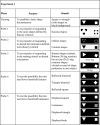Do rats use shape to solve "shape discriminations"?
- PMID: 16705141
- PMCID: PMC1475809
- DOI: 10.1101/lm.84406
Do rats use shape to solve "shape discriminations"?
Abstract
Visual discrimination tasks are increasingly used to explore the neurobiology of vision in rodents, but it remains unclear how the animals solve these tasks: Do they process shapes holistically, or by using low-level features such as luminance and angle acuity? In the present study we found that when discriminating triangles from squares, rats did not use shape but instead relied on local luminance differences in the lower hemifield. A second experiment prevented this strategy by using stimuli-squares and rectangles-that varied in size and location, and for which the only constant predictor of reward was aspect ratio (ratio of height to width: a simple descriptor of "shape"). Rats eventually learned to use aspect ratio but only when no other discriminand was available, and performance remained very poor even at asymptote. These results suggest that although rats can process both dimensions simultaneously, they do not naturally solve shape discrimination tasks this way. This may reflect either a failure to visually process global shape information or a failure to discover shape as the discriminative stimulus in a simultaneous discrimination. Either way, our results suggest that simultaneous shape discrimination is not a good task for studies of visual perception in rodents.
Figures





Similar articles
-
Accuracy of Rats in Discriminating Visual Objects Is Explained by the Complexity of Their Perceptual Strategy.Curr Biol. 2018 Apr 2;28(7):1005-1015.e5. doi: 10.1016/j.cub.2018.02.037. Epub 2018 Mar 15. Curr Biol. 2018. PMID: 29551414 Free PMC article.
-
Studying decision making in rats using a contextual visual discrimination task: Detection and prevention of alternative behavioral strategies.J Neurosci Methods. 2025 Mar;415:110346. doi: 10.1016/j.jneumeth.2024.110346. Epub 2024 Dec 10. J Neurosci Methods. 2025. PMID: 39667672
-
The visual computation of 2-D area by human observers.Vision Res. 2005 Sep;45(19):2564-70. doi: 10.1016/j.visres.2005.04.004. Vision Res. 2005. PMID: 15904946
-
Perceptual deficits after lesions of inferotemporal cortex in macaques.Cereb Cortex. 2000 Jul;10(7):671-83. doi: 10.1093/cercor/10.7.671. Cereb Cortex. 2000. PMID: 10906314
-
Confronting complexity: insights from the details of behavior over multiple timescales.Dev Sci. 2008 Mar;11(2):209-15. doi: 10.1111/j.1467-7687.2007.00667.x. Dev Sci. 2008. PMID: 18333976 Review.
Cited by
-
Accuracy of Rats in Discriminating Visual Objects Is Explained by the Complexity of Their Perceptual Strategy.Curr Biol. 2018 Apr 2;28(7):1005-1015.e5. doi: 10.1016/j.cub.2018.02.037. Epub 2018 Mar 15. Curr Biol. 2018. PMID: 29551414 Free PMC article.
-
A rodent model for the study of invariant visual object recognition.Proc Natl Acad Sci U S A. 2009 May 26;106(21):8748-53. doi: 10.1073/pnas.0811583106. Epub 2009 May 8. Proc Natl Acad Sci U S A. 2009. PMID: 19429704 Free PMC article.
-
The touchscreen operant platform for testing learning and memory in rats and mice.Nat Protoc. 2013 Oct;8(10):1961-84. doi: 10.1038/nprot.2013.122. Epub 2013 Sep 19. Nat Protoc. 2013. PMID: 24051959 Free PMC article.
-
A computationally informed comparison between the strategies of rodents and humans in visual object recognition.Elife. 2023 Dec 11;12:RP87719. doi: 10.7554/eLife.87719. Elife. 2023. PMID: 38079481 Free PMC article.
-
North American river otters (Lontra canadensis) discriminate between 2D objects varying in shape and color.Learn Behav. 2019 Mar;47(1):91-104. doi: 10.3758/s13420-018-0346-x. Learn Behav. 2019. PMID: 30251106
References
-
- Bussey T., Muir J.L., Robbins T.W. A novel automated touchscreen procedure for assessing learning in the rat using computer graphic stimuli. Neurosci. Res. Commun. 1994;15:103–110.
-
- Bussey T.J., Saksida L.M., Rothblat L.A. Discrimination of computer-graphic stimuli by mice: A method for the behavioral characterization of transgenic and gene-knockout models. Behav. Neurosci. 2001;115:957–960. - PubMed
-
- Cook R.G., Geller A.I., Zhang G.R., Gowda R. Touchscreen-enhanced visual learning in rats. Behav. Res. Methods Instrum. Comput. 2004;36:101–106. - PubMed
-
- Fields P.E. Studies in concept formation. The development of triangularity by the white rat. Comparative Psychology Monographs. 1932;9:1–70.
-
- Gaffan E.A., Eacott M.J. A computer-controlled maze environment for testing visual memory in the rat. J. Neurosci. Methods. 1995;60:23–37. - PubMed
Publication types
MeSH terms
LinkOut - more resources
Full Text Sources
